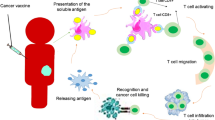Abstract
The specific humoral immune response against Epstein-Barr virus (EBV) antigens in patients with nasopharyngeal carcinoma (NPC) was compared to that of patients with infectious mononucleosis (IM) and other EBV-seropositive subjects using immunoblotting technique. Almost all sera from E,BV serologically associated NPC reacted reproducibly with a major group of polypeptides (four to six) of early antigen (EA) complex with molecular weights ranging from 50 kD to 58 kD, and with some additional polypeptides. Sera from IM-patients reproducibly recognized only one polypeptide of 50 kD belonging to the major group of polypeptides of EA-complex. Sera from patients with other types of head and neck cancer and relatively high levels of IgG antibody against viral capsid antigen (VCA) and EA did not react reproducibly with any of the EBV-associated proteins.
Similar content being viewed by others
References
AlldayM.J., McGillivrayA.J. (1985): Epstein-Barr virus nuclear antigen (EBNA): size polymorphism of EBNA1. - J. Gen. Virol. 66: 1595–1600.
BatteigerB., NewhallJ., JonesR.B. (1982): The use of tween-20 as blocking agent in the immunological detection of proteins transferred to nitrocellulose membranes. - J. Immunol. Methods 55: 297–307.
BodemerW.W., SummersW.C., NiedermanJ.C. (1980): Detection of virus-specific antigens in EB-(P3HRl) virus-superinfected Raji cells by immunoprecipitation.- Virology 103: 340–349.
CeveniniR., DonatiM., RumpianesiF. (1982): Primary Epstein-Barr virus infection in children with malignant disorders. Effect of therapy on EBV antibodies. - J. Infection 5: 73–79.
CeveniniR., DonatiM., RumpianesiF., MoroniA., PaolucciP. (1984): An immunoperoxidase assay for the detection of specific IgA antibody in Epstein-Barr virus inflections. - J. Clin. Pathol. 37: 440–443.
CeveniniR., DonatiM., CalicetiU., MoroniA., TambaI., RumpianesiF. (1986): Evaluation of antibodies to Epstein-Barr virus in Italian patients with nasopharyngeal carcinoma. - J. Infection 12: 127–131.
DeSchryverA., FribergS., KleinG., HenleW., HenleG., DeThèG., CliffordP., HoH.C. (1969): Epstein-Barr virus associated antibody patterns in carcinoma of post-nasal space. - Clin. Experimen. Immunol. 5: 443–459.
DolkenG., HechtT., WeitzmannU., WagnerM., LohrG., HirschF. (1986): Purification of a polypeptide complex (p52) belonging to the D-subspecificities of Epstein-Barr virus-induced early antigens. - Virology 148: 58–73.
GazzoloL., DeThèG., VuillaumeM., HoH.C. (1972): Nasopharyngeal carcinoma II. Ultrastructure of normal mucosa, tumor biopsies, and subsequent epithelial growth in vitro. - J. Nat. Cancer Inst. 48: 73–86.
HadarT., RahimaM., KahanE., SidiJ., RakowskiE., SarovB., SarovI. (1986): Significance of specific Epstein-.Barr virus IgA and elevated IgG antibodies to viral capsid antigens in nasopharyngeal carcinoma patients. - J. Med. Virol. 20: 329–339.
HenleG., HenleW., KleinG. (1971): Demonstration of two distinct components in the early antigen complex of Epstein-Barr virus infected cells. - Int. J. Cancer 8: 272–283.
HenleG., HenleW. (1976): Epstein-Barr virus-specific serum antibodies as outstanding feature of nasopharyngeal carcinoma. - Int. J. Cancer 17: 1–7.
KallinB., LukaJ., KleinG. (1979): Immunochemical characterization of Epstein-Barr virus-associated early and late antigens in n-butyrate-treated P3HR1 cells. - J. Virol. 32: 710–716.
KleinG. (1979): The relationship of the virus to nasopharyngeal carcinoma. In: Epstein M.A., Achong B.G.(eds) ≪ The Epstein-Barr virus ≫. Springer-Verlag, Berlin, Heidelberg, New York. pp. 339–350.
KruegerG.R.F., WustrowJ. (1981): Current histological classification of nasopharyngeal carcinoma (NPC) at Cologne University. In: Grundman E., Krueger G.R.F., Ablashi D.V. (eds): Cancer Campaign: nasopharyngeal carcinoma. Gustav Fisher Verlag, Stuttgart, New York. pp. 11–15.
LaemmliU.K. (1970): Cleavage of structural proteins during the assembly of the head of bacteriophage T4. - Nature 227: 680–685.
LunJ.C., ChoiE.I., PaganoJ. (1985): Qualitative and quantitative analyses of Epstein-Barr virus early antigen diffuse component by blotting enzyme-linked immunosorbent assay with a monoclonal antibody. - J. Virol. 53: 793–799.
OldL., BoyseE.A., OettgenH.F., deHarvenE., GeeringG., WilliamsonB. (1966): Precipitating antibody in human serum to an antigen present in cultured Burkitt's lymphoma cells. - P.N.A.S. 56: 1699–1704.
PearsonG.R., WilandL.F., BryanN.H. (1981): Evaluation of antibodies to Epstein-Barr virus (EBV) in the diagnosis of American nasopharyngeal carcinoma. In: Grundman E., Krueger G.R.F., Ablashi D.V. (eds.): Cancer Campaign: nasopharyngeal carcinoma. Gustav Fisher Verlag. Berlin, Stuttgart, New York. pp. 231–236.
PearsonG.R., VromanB., ChaseB., SculleyT., HummelM., KiefE. (1983): Identification of polypeptide components of Epstein-Barr virus early antigen complex with monoclonal antibodies. -J. Virol. 47: 193–201.
ReedmanB.M., KleinG. (1973): Cellular localization of an Epstein,Barr virus (EBV);associated complement-fixing antigen in producer and non-producer lymphoblastoid cell lines. - Int. J. Cancer 11: 499–520.
SculleyT.B., WalkerP.J., MossD.J., PopeJ. (1984): Identification of multiple Epstein-Barr virus-induced nuclear antigen with sera from patients with rheumathoid arthritis. - J. Virol. 52: 88–93.
SculleyT.B., SculleyD.G., PopeJ.H. (1985): Identification of Epstein-Barr virus-induced polypeptides in P3HR1-cells by protein immunoblot. -J. Gen. Virol. 66: 1113–1122.
StrnadB., SchusterT., HopkinsR.F., Neubauer R.H., RabinH. (1981): Identification of an Epstein-Barr virus nuclear antigen by fluoro-immuno electrophoresis and radioimmunoelectrophoresis. -J. Virol. 38: 996–1004.
TowbinH., StaehelinT., GordonJ. (1979): Electrophoretic transfer of proteins from polyacrylamide gels to nitrocellulose sheets: procedure and some applications. - P.N.A.S. 76: 4350–4354.
YammamotoN., Zur HausenH. (1980): Effect of inhibition of DNA synthesis on Epstein-Barr virus induction by tumor promoters. - Virology 101: 104–110.
Author information
Authors and Affiliations
Rights and permissions
About this article
Cite this article
Cevenini, R., Donati, M., Moroni, A. et al. Specific epstein-barr virus serological response in patients with nasopiiaryngeal carcinoma detected by immunoblotting. Eur J Epidemiol 4, 301–305 (1988). https://doi.org/10.1007/BF00148913
Issue Date:
DOI: https://doi.org/10.1007/BF00148913




